Stores Ref. A1/AA 1493 Pouch, basic, W.E. Patt. ’37, Mk. I.
Stores Ref. CN/AA 1493 Web Equipment, Patt. ’37, Pouch, basic, Mk. 1
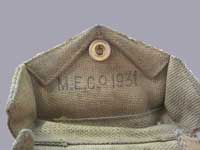
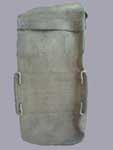
 This article was the defining design characteristic of Patt. ’37 W.E., but was simply a larger version of a Magazine Pouch designed experimentally in the 30s, for a Vickers Berthier L.M.G. Equipment. Once again, an old design re-treaded by Mills, in a very proper and economical engineering process. You do not, if avoidable, re-design the wheel. The photographs at right show a 1931 dated Vickers Berthier Pouch, maker marked "M.E. Co." From the J. W. Newton Collection, photos © J. W. Newton 2009.
This article was the defining design characteristic of Patt. ’37 W.E., but was simply a larger version of a Magazine Pouch designed experimentally in the 30s, for a Vickers Berthier L.M.G. Equipment. Once again, an old design re-treaded by Mills, in a very proper and economical engineering process. You do not, if avoidable, re-design the wheel. The photographs at right show a 1931 dated Vickers Berthier Pouch, maker marked "M.E. Co." From the J. W. Newton Collection, photos © J. W. Newton 2009.
The first issue of Basic pouch had no Mark Number, none being required. Under the box-lid flap, there were three cartridge loops. These were mostly cut from an integrally woven strip and stitched into place. Although not mentioned, in any official document yet seen, they are believed to be for ballistite cartridges. These were blank cartridges, with a more potent load than ordinary blanks, and were used to propel No. 36 Grenades from a Discharger Cup. Some early Pouches do not have the loops. They may have been made that way, or they could have been removed (although see below for a suggestion). The Pouches are not “handed”, so it is impossible to establish if pairs of Pouches were intended, one with and one without loops.
The pouches were of stitched construction, double layer overall and triple at the lower part. On the back, a 4-bar Mills patent buckle was held by a piece of webbing, of “waisted” shaped, folded in half around the buckle. This was stitched vertically, on each side, leaving a fairlead between the stitching, at the top of the pouch. Half-way down the pouch body, thin web was used to patch on a pair of Hooks, brass, 2 1/4-in. The post 1951 CN code used an Arabic “1” – correctly - as Roman numerals had been abandoned late in the War.


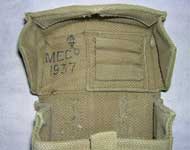 An early first issue Pouch, basic, W.E. Patt. '37, as introduced in List of Changes No. L. of C. §B1623, dated 8th June 1938. The ballistite (presumably) loops are visible in the lid. This example has been well used, having been green blancoed and then khaki blancoed over that (and note the wear on the belt hooks!), but has never been modified and still retains its first issue characteristics. It is maker marked "M.E.Co." and dated 1937.
An early first issue Pouch, basic, W.E. Patt. '37, as introduced in List of Changes No. L. of C. §B1623, dated 8th June 1938. The ballistite (presumably) loops are visible in the lid. This example has been well used, having been green blancoed and then khaki blancoed over that (and note the wear on the belt hooks!), but has never been modified and still retains its first issue characteristics. It is maker marked "M.E.Co." and dated 1937.


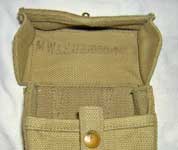 A second issue Mk. I Pouch. This example is in as-new, unissued condition, and does not show any evidence of every having cartridge loops in the lid. It is maker marked "M.W. & S. Ltd." and is dated 1939.
A second issue Mk. I Pouch. This example is in as-new, unissued condition, and does not show any evidence of every having cartridge loops in the lid. It is maker marked "M.W. & S. Ltd." and is dated 1939.
Reference should be made to the abstracted tables and text from the following:-
2. Infantry Training Part VIII Fieldcraft, Battle Drill, Section and Platoon Tactics, 1944
Each member of the infantry section carried a certain number of filled Bren magazines. Although designed for 30 rounds, it was general practice to load only 28, to save straining the magazine spring. This becomes obvious in the table at (2).
In 1939, the Section comprised 8 men, a Commander and “Nos. 1 to 7”, of which Nos. 1 and 2 were the Bren group. Nos. 2 to 7 carried rifles. Each man carried three Bren magazines, two in one Basic pouch and a Bandolier, cotton, 50 rounds in chargers, together with the third magazine in the other Basic pouch. Note the faint hand-written annotation “…Sten or Tommy Gun…”.
In 1941, Amendment No. 1 to S.A.T. Vol. 1, Pam. 4 was issued with Army Council Instructions of 28th June. This substituted a Thompson Machine Carbine (T.M.C.) for the Commander’s rifle and removed his Cotton bandolier, though he still carried two Bren magazines.
Although not mentioned in the 1941 Amendment, the 1942 edition of S.A.T. Vol. 1, Pam. 4 shows the Commander with six T.M.C. magazines. He also now carried wire-cutters* and a matchet*, as the British Army termed the machete. The section Numbers had been revised and the disposition of magazines changed, as grenades had been added to the load.
(*These items will be added to Patt. ’37 Associated Equipment)
By 1944, the Section had increased to ten men, their roles revised again to riflemen, Nos. 1 to 6, the Section 2 i/c and Bren No. 2 both carried rifles too. The table shows two Cotton bandoliers being carried, one dedicated to the rifles, the other for re-loading empty Bren magazines. The second Bandolier is usually seen slung, the other being in the Basic pouch, along with grenades. The Commander’s (expensive) T.M.C. had also been replaced with the cheaper Sten Machine Carbine (S.M.C.).
By 1948, the infantry Section had reverted to an eight man composition, two Cotton bandoliers still being carried and the Commander additionally carrying a Map case.
Stores Ref. A1/AA 1493 Pouch, basic, W.E. Patt. ’37, Mk. I . (modified) UPDATED!
The claim made for the new Pattern was that all items (bar the bayonet) would be worn above the waist, in Battle Order. The trials of 1937 evidently did not reveal any problems, but one soon emerged when the Pattern went into general use. Sitting down, whilst wearing the Basic pouches, forced them into the wearer’s thighs, causing some discomfort.
A.C.I. 604/1940 remedied this problem, authorising the belt hook patch to be removed and re-stitched 1-inch lower down the pouch body. This raised the pouch further above the belt line. Modified Mark I pouches were also termed Mark II.
A modified Mk. I Basic pouch. A view of the rear will clearly show the modifications. Inside the lid, it is also clear from the position of the stampings that this Pouch once had the same type of cartridge loops as the 1937 dated example shown above.


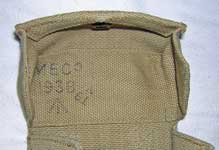 Another modified Basic pouch. It is especially interesting, though as the construction marks visible on the rear demonstrate that, rather than being converted from a Pouch, basic, W.E. Patt. 1937, Mk. I, this one started life as a Pouch, basic, W.E. Patt. ‘08, and has been modified by replacing both the upper 4-bar buckle patch and the belt hook patch. As with the modified Mk. I Pouch, this example also once had the same type of cartridge loops as the 1937 dated example shown above. This Pouch is maker marked "M.E.Co." and dated 1938.1
Another modified Basic pouch. It is especially interesting, though as the construction marks visible on the rear demonstrate that, rather than being converted from a Pouch, basic, W.E. Patt. 1937, Mk. I, this one started life as a Pouch, basic, W.E. Patt. ‘08, and has been modified by replacing both the upper 4-bar buckle patch and the belt hook patch. As with the modified Mk. I Pouch, this example also once had the same type of cartridge loops as the 1937 dated example shown above. This Pouch is maker marked "M.E.Co." and dated 1938.1
Stores Ref. A1/AA 1494 Pouch, basic, W.E. Patt. ’37, Mk. II
Stores Ref. CN/AA 1494 Web Equipment, Patt. ’37, Pouch, basic, Mk. II

 Consequent on A.C.I. 604/1940, future production was with low-set belt hooks and were designated as Mark II. List of Changes No. L. of C. §B3617 notified this modification, the new production standard. The original issue pouches were effectively Mark I, which was now declared obsolescent. In L. of C. §C4686, despite the Arabic number on the Mark 1, the Mark II and III below remained with inconsistent Roman numbers. The example shown left is maker marked "M.W. & S. Ltd." and dated 1941.
Consequent on A.C.I. 604/1940, future production was with low-set belt hooks and were designated as Mark II. List of Changes No. L. of C. §B3617 notified this modification, the new production standard. The original issue pouches were effectively Mark I, which was now declared obsolescent. In L. of C. §C4686, despite the Arabic number on the Mark 1, the Mark II and III below remained with inconsistent Roman numbers. The example shown left is maker marked "M.W. & S. Ltd." and dated 1941.
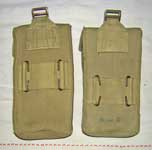
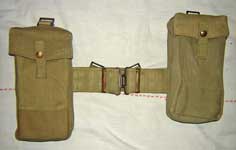 A comparison of the Mk. I and Mk. II Basic pouches. The picture far left shows rear views, with a 1939 Mk. I on the left and a 1941 Mk. II on the right. Both are by M.W. & S. The picture near left shows the same two Pouches mounted on a Patt. '37 Belt. As can readily be seen, the Mk. II Pouch (right) rides further up (which was, after all, the entire point of the modification). This alleviated the problem noted above but caused another one, especially for shorter men. When the Pack or Haversack is worn on the back, the Haversack straps, which connect to the top of the Pouch, can sometimes fit uncomfortably high under the wearer's arms.
A comparison of the Mk. I and Mk. II Basic pouches. The picture far left shows rear views, with a 1939 Mk. I on the left and a 1941 Mk. II on the right. Both are by M.W. & S. The picture near left shows the same two Pouches mounted on a Patt. '37 Belt. As can readily be seen, the Mk. II Pouch (right) rides further up (which was, after all, the entire point of the modification). This alleviated the problem noted above but caused another one, especially for shorter men. When the Pack or Haversack is worn on the back, the Haversack straps, which connect to the top of the Pouch, can sometimes fit uncomfortably high under the wearer's arms.
Stores Ref. A1/AA 5370 Pouch, basic, W.E. Patt. ’37, Mark III
Stores Ref. CN 1495 Web Equipment, Patt. ’37, Pouch, basic, Mark III
In 1940, the Sten Gun had yet to make its debut. When it did, yet another drawback emerged. The magazines would not fit a Mark II Pouch. List of Changes No. L. of C. §B6366 therefore introduced the Mark III Basic pouch, now made ½-inch longer and making the Mark II Pouch obsolescent. Early Mark III have the usual press-stud closure, but this changed quickly to a Q.R.buckle (Quick Release). The manufacture of a 2-part Q.R. buckle was simpler than that for a press fastener. In this, it made sense as “lean manufacturing”. However, in terms of ease of use, it was a pig! When the un-stiffened tabs became frayed, they were difficult to insert through the Staple, and anyway the Link often left insufficient space to accommodate the tab. The Mark Number did not advance, which would have made life easier for the collector. Post-war production was with Q.R. buckles. Another addition was an eyelet – called a grommet by the Army – in the base of the pouch. This was obviously to allow water to drain out, but it’s tempting to tie this to sea-water and the forthcoming D-Day…?
Despite two of the Marks being obsolescent, in the 1965 edition of Section CN of the Catalogue of Clothing and Necessaries, all three Marks were still listed. Immediately post-war, a change was made from Roman to Arabic numbering. They therefore appear as Marks 1, 2 and 3.

 A Mk. III Basic pouch, early type with press stud closure. This example is maker marked "H.H.C. & Co. Ltd." (H.H. Carroll & Co. Ltd.) and dated 1942.
A Mk. III Basic pouch, early type with press stud closure. This example is maker marked "H.H.C. & Co. Ltd." (H.H. Carroll & Co. Ltd.) and dated 1942.


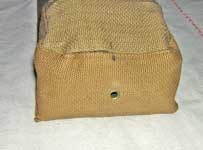 A later type Mk. III Basic Pouch with the Quick Release closure. Note the grommet added to the bottom, to allow water to drain out. This Pouch is maker marked "M.E. Co." and dated 1952.
A later type Mk. III Basic Pouch with the Quick Release closure. Note the grommet added to the bottom, to allow water to drain out. This Pouch is maker marked "M.E. Co." and dated 1952.
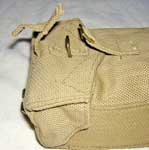
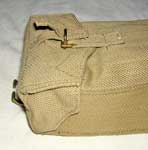 Details of the Quick Release closure. At far left, in the open position. The staple is fixed to the lid, as is the web tab. The short strap sewn to the link is attached to the body of the Pouch. Near left, the Pouch is closed. The link fits over the staple, and the end of the tab is tucked through. To release, just pull the free end of the tab. Simple enough - until, as noted above, the tab gets worn and starts to fray, after which it became a chore to thread the end through the staple.
Details of the Quick Release closure. At far left, in the open position. The staple is fixed to the lid, as is the web tab. The short strap sewn to the link is attached to the body of the Pouch. Near left, the Pouch is closed. The link fits over the staple, and the end of the tab is tucked through. To release, just pull the free end of the tab. Simple enough - until, as noted above, the tab gets worn and starts to fray, after which it became a chore to thread the end through the staple.
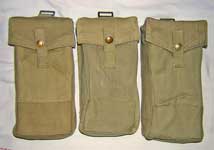
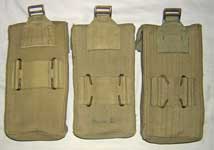 Basic pouches: left to right Mks. I, II, and III. These are the 1939, 1940, and 1942 dated examples shown above. The extra 1/2-inch length of the Mk. III is clearly visible in the front view, whilst in the rear view the higher location of the Mk. I's hooks is obvious.
Basic pouches: left to right Mks. I, II, and III. These are the 1939, 1940, and 1942 dated examples shown above. The extra 1/2-inch length of the Mk. III is clearly visible in the front view, whilst in the rear view the higher location of the Mk. I's hooks is obvious.
Stores Ref. A1/AA 5252 Pouch, basic, M.T. Drivers
Stores Ref. CN 1490 Web Equipment, Patt. ’37, Pouch, basic, M.T. Drivers

 The Pouch, basic, M.T. Drivers, was one of many wartime introductions, coded in the 5000 series, here introduced by A.C.I. 959/1944. Note that it did not originally have “Patt. ’37 W.E.” nomenclature, as with several items only added to the Pattern post-war. There was evidently no L. of C., which would have notified that it should be added to the V.A.O.S.. In consequence, in 1951, it was marked as N.I.V. in L. of C. §C4686, with no Old Designation. This L. of C. re-coded the wartime 5000 code allocations, on this pouch to CN 1490, in the course of which it was also entered under the W.E., Patt. ‘37 sub-title. The A.C.I. authorised the withdrawal of Carriers, cartridge from M.T. Drivers who, though not stated, had evidently exchanged their rifles for Sten M.C.s. Also authorised was the issue of a pair of Attachments, brace, so that Braces could be worn. Only a single Pouch was worn.
The Pouch, basic, M.T. Drivers, was one of many wartime introductions, coded in the 5000 series, here introduced by A.C.I. 959/1944. Note that it did not originally have “Patt. ’37 W.E.” nomenclature, as with several items only added to the Pattern post-war. There was evidently no L. of C., which would have notified that it should be added to the V.A.O.S.. In consequence, in 1951, it was marked as N.I.V. in L. of C. §C4686, with no Old Designation. This L. of C. re-coded the wartime 5000 code allocations, on this pouch to CN 1490, in the course of which it was also entered under the W.E., Patt. ‘37 sub-title. The A.C.I. authorised the withdrawal of Carriers, cartridge from M.T. Drivers who, though not stated, had evidently exchanged their rifles for Sten M.C.s. Also authorised was the issue of a pair of Attachments, brace, so that Braces could be worn. Only a single Pouch was worn.
The M.T. Drivers pouch was a Mark III pouch, but fitted only with a broad webbing belt loop, 2-inches wide. This allowed seated M.T. (Motor Transport) Drivers to wear the pouch “…on the left or right side whichever is more convenient when driving…”. All examples noted have a press-stud closure, not Q.R.
The example here is maker marked "Finnegans Ltd." and dated 1944.
Stores Ref. A1/AA 1515 Pouch, utility, front, with waist strap
Stores Ref. CN/AA 1515 Web Equipment, Patt. 37, Pouch, utility, front, with waist strap
These were introduced by List of Changes No. L. of C. §B1624, with the statement that they could be “…worn over either the patt. ’08 or the patt. ’37 web equipment…” – note the lack of capitals! As such, they were not given any Pattern Year nomenclature. It was an oversized Basic pouch, which could contain three Bren magazines, to the Basic pouch’s two magazines. This was settled-on as the best way to supplement ammunition carriage for the Bren L.M.G., Boys A.T. and 2-in. O.S.B. mortar. It could also take a Mark VI water bottle. Where the Basic pouch had a 1-in. 4-bar buckle (Buckle, brass, 1-in. with loop) at the top rear, the U.P. had a 3-bar buckle, of 1 1/2-inch strap accommodation, on a correspondingly wider chape / fairlead. At the bottom rear face, a 1-inch wide waist strap was stitched, carrying a 1-inch buckle. Viewed from the rear, the buckle extended to the right. On some early supplies, loops for ballistite cartridges were stitched to the underside of the lid. When Patt. ’08 W.E. was made obsolete by L. of C. §C2568, there was no need for a nomenclature change, but L. of C. §C4686 finally made them part of Patt. ’37 in 1951.
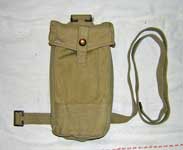
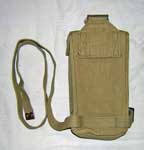 The Pouch, utility, front, with waist strap. Note the long 1-inch waist strap sewn to the bottom. This example is maker marked "M.E. Co." and dated 1939.
The Pouch, utility, front, with waist strap. Note the long 1-inch waist strap sewn to the bottom. This example is maker marked "M.E. Co." and dated 1939.
Stores Ref. A1/AA 1516 Pouch, utility, rear, with loop
Stores Ref. CN/AA 1516 Web Equipment, Patt. 37, Pouch, utility, rear, with loop

 The Pouch, utility, rear, with loop was the same size as the Front pouch, fitted with the same buckle, but with a wide fairlead at the base of the rear face. The waist strap was threaded through this, to connect with the 1-inch buckle on the Front pouch. This example is maker marked "M.E. Co." and dated 1939.
The Pouch, utility, rear, with loop was the same size as the Front pouch, fitted with the same buckle, but with a wide fairlead at the base of the rear face. The waist strap was threaded through this, to connect with the 1-inch buckle on the Front pouch. This example is maker marked "M.E. Co." and dated 1939.
Stores Ref. A1/AA 1990 Yoke, for Pouches, utility
Stores Ref. CN/AA 1990 Web Equipment, Patt. 37, Yoke
 The Yoke, for Pouches, utility, was a short strap, with a flare, that connected the two Pouches, so that they could be slung over the shoulder. They were illustrated, in the instructional pamphlet, slung with the Front pouch to the left and rear to the right, behind the wearer’s right shoulder. Other styles were, as usual, adopted by Bren Gun Numbers, the most unusual foreshadowing the “chest rigs” of the late 20th Century. This was in the Far East campaign, where a second Rear pouch was added to the standard pair, all three being grouped across the stomach. To allow sufficient length, two Yokes must have been joined together behind the wearer’s neck. This example is maker marked "M.E. Co." and dated 1939.
The Yoke, for Pouches, utility, was a short strap, with a flare, that connected the two Pouches, so that they could be slung over the shoulder. They were illustrated, in the instructional pamphlet, slung with the Front pouch to the left and rear to the right, behind the wearer’s right shoulder. Other styles were, as usual, adopted by Bren Gun Numbers, the most unusual foreshadowing the “chest rigs” of the late 20th Century. This was in the Far East campaign, where a second Rear pouch was added to the standard pair, all three being grouped across the stomach. To allow sufficient length, two Yokes must have been joined together behind the wearer’s neck. This example is maker marked "M.E. Co." and dated 1939.
 The inside view of the same Yoke shown above.
The inside view of the same Yoke shown above.
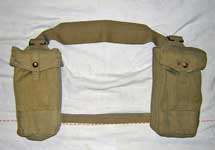
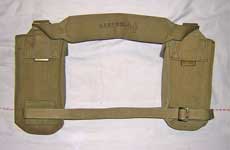 The Front pouch, Rear pouch, and Yoke, here connected in the standard fashion and ready to be worn. All three items are maker marked "M.E. Co." and dated 1939.
The Front pouch, Rear pouch, and Yoke, here connected in the standard fashion and ready to be worn. All three items are maker marked "M.E. Co." and dated 1939.
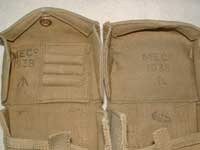 Two 1938 dated Mk. I Utility pouches. In each case, the manufacturer was Mills. The first example has cartridge loops, while the location and type of stamp in the second indicates that it was manufactured without cartridge loops. Based on this, it appears that the loops were deleted from the manufacturing specification some time in 1938. From the Allen Prior Collection, photos © Allen Prior 2009.
Two 1938 dated Mk. I Utility pouches. In each case, the manufacturer was Mills. The first example has cartridge loops, while the location and type of stamp in the second indicates that it was manufactured without cartridge loops. Based on this, it appears that the loops were deleted from the manufacturing specification some time in 1938. From the Allen Prior Collection, photos © Allen Prior 2009.